History of psychology at Penn
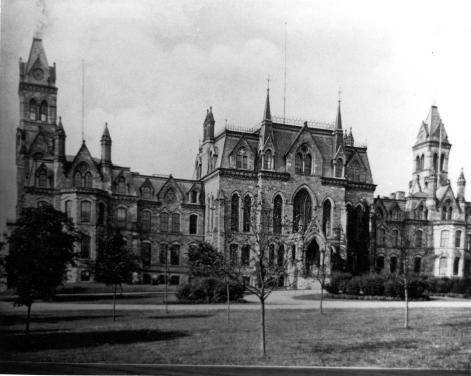
College Hall was the site of the Department from the beginning until 1966.
Psychology has been at the University of Pennsylvania since
1887. From the start it has emphasized both scientific rigor and
practical application, not always at the same time. The first
professor, James McKeen Cattell, was an advocate of scientific
method and careful data collection (with expensive apparatus).
One of his successors, Lightner Witmer, was the inventor of the
term "clinical psychology" and the founder of the first
"psychological clinic" in the U.S.
In the 1960s, Pennsylvania made a bold move to improve the
quality of the Department. But this was one of many events that
provide focal points for the present account.
These pages are a work in progress. Comments and contributions
are welcome.
Material in these pages comes from various sources, including the
Archives of the University of Pennsylvania and the less
formal archives of the Department itself (various file folders
lying around in the old Fernberger Library), and personal
collections of Department members. Paul Rozin compiled a lot of
this material for a centennial celebration in 1987.
Christopher Green's
Classics in the History of
Psychology has been most helpful.
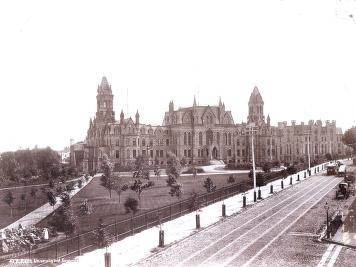
College Hall (and Logan Hall) viewed from Woodland Ave., ca. 1892.
The beginning: James McKeen Cattell
At the end of the 1880s, several American colleges and
universities wanted to expand into the new field of psychology in
various ways. Penn was among the first, along with Johns Hopkins
and Indiana. Arguably, the first professor of psychology in the
U.S. was James McKeen Cattell.
Cattell began what is now the Department of Psychology, but left
after a few years for Columbia. He had an interesting career.
The founding of the American Psychological Association
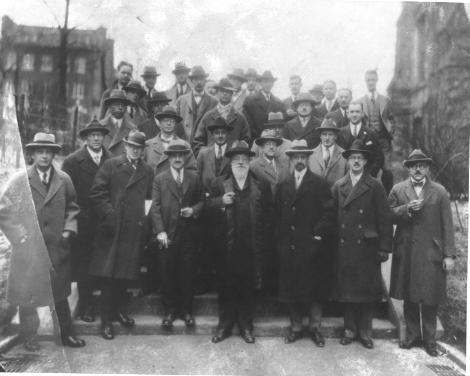
1926 APA meeting
Penn played an important role in American psychology. Penn
faculty were among the founders of the American Psychological
Association, and the first annual meeting was held here in 1892,
as well as the meeting of 1926.
Cattell's
copy of the Proceedings
Proceedings of the first annual meeting, held at Penn
Fernberger's historical summary
The psychological laboratory
From the beginning the
laboratory was a
place for both teaching and research.
Lightner Witmer and the beginning of clinical psychology
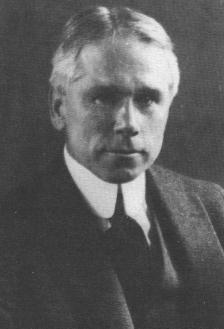
Witmer
Witmer was the inventor of the term
"clinical psychology" and the founder of the first psychological
clinic (1896).
Edwin B. Twitmyer and the knee-jerk reflex:
Twitmyer discovered the conditioned
reflex before Pavlov. He was puzzled why his results did not
arouse more interest when he presented them to the APA meeting in
1904.
The curriculum in 1910
In some ways, the courses offered in
1910 are similar to those offered today. In other ways, they are
different.
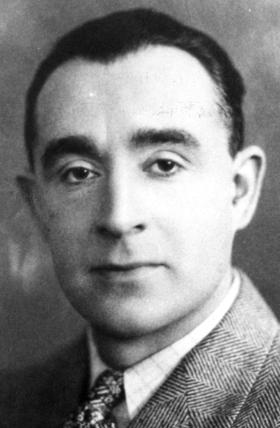
Viteles
Morris Viteles and the beginning of industrial psychology
Clinical psychology was not the only applied area to begin at Penn.
Morris Viteles started the field of industrial psychology.
Unlike Witmer, though, Viteles remained the sole representative
of this field in the department.
Robert Bush and the new department
In 1958, Robert Bush, a mathematical psychologist with a doctorate in
physics, was chosen as chair, a position he occupied until 1964. He
had a mandate to re-build the department,
which he did with gusto (and help from some of the new members he
hired).
Cognitive science
Ulrich Neisser wrote Cognitive Psychology (1967) while he
was at Penn, in the Psychiatry Department. In the early 1970s,
Justin Aronfreed created interest in cognitive development and
attracted Rochel Gelman to Penn. Gelman attracted others and
found colleagues in other fields and departments, including Lila
Gleitman, a psycholinguist who moved from the Graduate School of
Education into the Psychology Department. Gelman, Gleitman, and
(in particular) Bonnie Webber of the Computer Science department
organized a cognitive lunch, which, in turn, led to a cohesive
inter-disciplinary group of cognitive scientests.
In 1978, the group started a formal program, with funding from the
Alfred P. Sloan Foundation. In 1991 the National Science Foundation
provided funding for the
Institute
for Research in Cognitive Science, as a Science and Technology
Center.
The graduate program and the demise of major areas
Under Bush, the graduate program had several "major areas," which
included clinical, developmental, cognitive, sensation/perception,
social, and learning. Each major area had a head (or czar). The
head, consulting with the members, made up the standard Ph.D.
qualifying examination, which was called a "major area exam."
In 1978, the department decided to abolish major areas.
Instead, graduate students would design their own programs and
choose their committees. The idea was both to encourage work
that drew on several traditional areas and to reduce the power of
the czars.
The change permeated the way people thought of the department.
It became "one department," with overlapping loyalties, loose
ties among faculty, and changing coalitions. Attempts to put
Humpty Dumpty back together again and define non-overlapping
"areas of interest" within the department have repeatedly run
into trouble. The current
classification of faculty is thus represented as overlapping
categories.
The recent history of the department
The recent history of the department is best described in terms
of several of the (overlapping) areas of interest.
The rejuvenation of clinical psychology
In part because of the changed atmosphere that resulted from the
abolition of major areas, it became possible for the department
as a whole to define its goals. Martin Seligman and David
Williams - both originally interested in learning - had become
seriously interested in clinical psychology. A committee headed
by Jonathan Baron recommended in 1979 that the department
re-build clinical psychology and try to maintain its
accreditation by the American Psychological Association. (The
other faculty members were Seligman and Williams, and the
committee also included four graduate students: Andrew Borson,
Rosemary Mongan, Jackie Persons, and Karen Schwartz.) After
raucous debate, the department faculty approved the report.
Several professors were hired, including Robert DeRubeis, who
became head of the APA-approved clinical program. When he became
department chair, Dianne Chambless joined the faculty and took
over that position.
Martin Orne
Martin T. Orne came to Penn in 1964, where he founded the Unit
for Experimental Psychiatry, located at
The Institute of Pennsylvania Hospital until 1995. He is known for his work on
demand characteristics of psychology experiments, hypnosis, and
"coercive persuasion," among other topics. He had long-standing
ties with the Department of Psychology, including advising of
graduate students.
At the request of Emily Orne and David Dinges, after his death
in 2000, Joanne and Robert Rosellini put together a web site with biographical material and reprints of
classic articles, hosted on this server.
Richard Solomon and his students

Solomon Psychology Laboratory, completed 1966.
Richard L. Solomon was a major contributor to the psychology of
learning. He had many well-known graduate students. Two of
them, Robert Rescorla and Martin Seligman, returned to Penn and
are now on the faculty. Our laboratory building
was named in his honor after his death.
Solomon Asch at Penn
Solomon Asch came to Penn in 1972 as head (czar) of the cognitive major area.
Asch was famous for his extensive work in
social psychology. But he had a long-standing interest in what we
now call cognitive psychology, especially memory but also other topics
such as metaphor. He spent most of his career at Swarthmore College
(where Henry Gleitman was once his research assistant), but came to
Penn from Rutgers, where he was head of the Institute for Cognitive
Studies. During his time here, he was mostly occupied with research
on memory and association, but he also helped to build the social
psychology area at Penn. He retired in 1979 and died in 1996. In 1998,
Paul Rozin and Clark (Rick) McCauley founded the Asch Center for Study
of Ethnopolitical Conflict, which moved to
Bryn Mawr in
2008.
Sensation and perception

Leo Hurvich
Bush brought to the department Jacob Nachmias, David Green, Saul
Sternberg, Leo Hurvich, and Dorothea
Jameson Hurvich. Recently the strength of this area has been
re-built with the addition of several new faculty members.
Cognitive neuroscience
In the 1970s, Paul Rozin began to explore what is now a very hot
field. Others were hired. Eventually, Martha Farah came to
stay, and three other faculty members have recently joined us in
this area: Sharon Thompson-Schill, Amishi Jha, and Russell Epstein.
The department today
Our web page describes the
department today.
Further reading
Classics in the History of
Psychology.
Sokal, M. M. (1981). An Education in Psychology: James McKeen
Cattell's Journal and Letters from Germany and England, 1880-1888.
Cambridge, MA: MIT Press.
McReynolds, P. (1997). Lightner Witmer: His Life and Times. Washington:
A.P.A.
Jonathan Baron
Last modified: Fri Mar 7 01:48:30 EST 2008



 1926 APA meeting
1926 APA meeting



